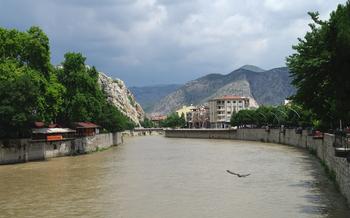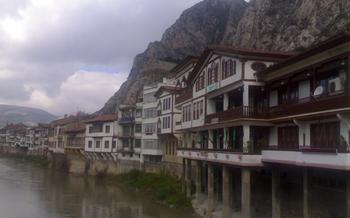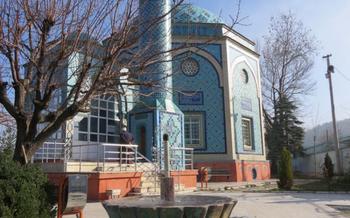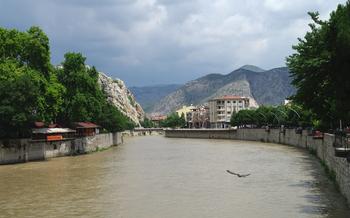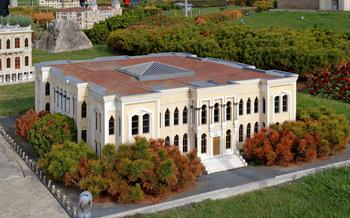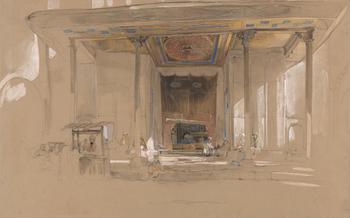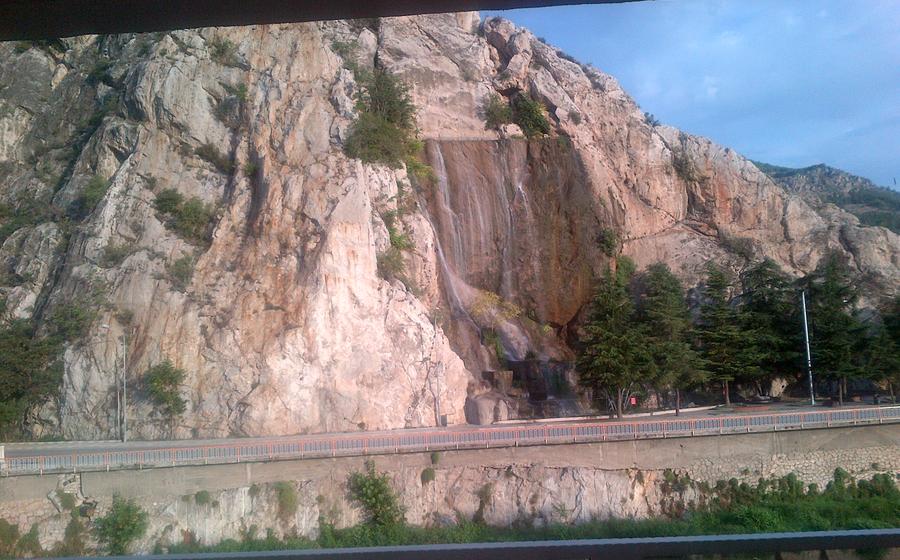
Amasya University Archaeology Department Excavations
- Amasya University Archaeology Department Excavations
- Location
- History of Amasya
- The Ancient City of Amasya
- The Pontic Kingdom
- The Byzantine Empire
- The Ottoman Empire
- The Turkish Republic
- The Amasya Museum
- The Amasya Castle
- The Sultan Bayezid II Complex
- The Great Mosque of Amasya
- The Ferhat Pasha Mosque
- The Gökmedrese
- Insider Tip
Amasya University Archaeology Department Excavations
The Amasya University Archaeology Department Excavations are a series of ongoing archaeological excavations that are being conducted at the ancient city of Amasya in Turkey. The excavations are being led by a team of archaeologists from Amasya University, and they have been ongoing since 20The excavations have revealed a wealth of information about the ancient city of Amasya, including its history, culture, and architecture.
The excavations have revealed the remains of a number of important buildings and structures, including a temple, a theater, a bathhouse, and a residential district. The excavations have also uncovered a number of artifacts, including pottery, coins, and jewelry. These artifacts have helped to shed light on the daily lives of the people who lived in Amasya in ancient times.
Location
The Amasya University Archaeology Department Excavations are located in the city of Amasya, in the northern part of Turkey. The excavations are situated on the edge of the city, near the banks of the Yeşil River. To get to the excavations, you can take a taxi or a bus from the city center. The excavations are open to the public, and there are guided tours available.
There are several other attractions located near the Amasya University Archaeology Department Excavations. These attractions include the Amasya Museum, the Amasya Castle, and the Great Mosque of Amasya. The Amasya Museum is home to a collection of artifacts from the history of Amasya, including many artifacts from the excavations. The Amasya Castle is a medieval castle that was built by the Seljuk Turks. The Great Mosque of Amasya is a 13th-century mosque that is one of the most important historical landmarks in the city.
History of Amasya
Amasya has a rich and varied history, dating back to the Hittites in the 2nd millennium BC. The city was later ruled by the Persians, Greeks, Romans, Byzantines, Seljuks, and Ottomans. Amasya was the capital of the Pontic Kingdom from 302 to 63 BC and was an important city in the Byzantine Empire. The city was also a major center of learning during the Ottoman period and was home to many madrasahs and libraries.
Amasya was the birthplace of the Ottoman sultan Bayezid II and was also the site of the Battle of Amasya in 1402, which resulted in the defeat of the Ottoman army by Timur. The city was also the site of the signing of the Treaty of Amasya in 1555, which ended the Ottoman-Safavid War.
Today, Amasya is a modern city with a population of over 130,000 people. The city is home to a number of historical sites, including the Amasya Castle, the Great Mosque of Amasya, and the Ferhat Pasha Mosque. Amasya is also a popular tourist destination, thanks to its beautiful scenery and its rich history.
The Ancient City of Amasya
The ruins of the ancient city of Amasya are located on a hill overlooking the modern city. The city was founded in the 6th century BC by the Persians and was later ruled by the Greeks, Romans, and Byzantines. The city was abandoned in the 13th century AD after it was destroyed by the Mongols.
The most important buildings and structures that have been excavated include the city walls, the agora, the theater, and the temple of Zeus. The city walls were built in the 4th century BC and were over 2 kilometers long. The agora was the marketplace of the city and was surrounded by shops and temples. The theater was built in the 2nd century BC and could seat up to 5,000 people. The temple of Zeus was built in the 1st century BC and was one of the largest temples in the city.
The excavations of the ancient city of Amasya have revealed a wealth of information about the city's history and culture. The city was a major center of trade and commerce and was home to a diverse population of people. The city was also a center of learning and culture, and was home to a number of schools and libraries.
The artifacts from the ancient city of Amasya are on display in the Amasya Museum. The museum houses a collection of over 10,000 artifacts, including sculptures, pottery, and coins. The museum also has a section on the history of the city, which includes a number of maps and photographs.
The Pontic Kingdom
The Pontic Kingdom was an ancient Greek state founded in the 3rd century BC by Mithridates I Ctistes, a Persian satrap who had declared his independence from the Seleucid Empire. The kingdom was centered in the region of Pontus, which corresponds roughly to the modern-day Turkish province of Samsun.
The Pontic Kingdom reached its peak under Mithridates VI Eupator, who ruled from 120 to 63 BC. Mithridates was a skilled military leader and a patron of the arts and sciences. He fought a series of wars against the Roman Republic, but was eventually defeated by Pompey the Great.
The Pontic Kingdom was a major power in the eastern Mediterranean for over two centuries. It was a center of Greek culture and learning, and its influence can still be seen in the region today.
Some of the most important kings of the Pontic Kingdom include:
- Mithridates I Ctistes (281-266 BC)
- Pharnaces I (185-170 BC)
- Mithridates V Euergetes (150-120 BC)
- Mithridates VI Eupator (120-63 BC)
- Pharnaces II (63-47 BC)
Some of the most important historical events that took place during the Pontic Kingdom include:
- The Mithridatic Wars (113-63 BC)
- The Roman conquest of Pontus (63 BC)
- The establishment of the Roman province of Bithynia and Pontus (64 AD)
The Byzantine Empire
The Byzantine Empire was a continuation of the Roman Empire in the East, and it ruled over Amasya from the 4th to the 11th century AD. During this time, Amasya was an important city in the Byzantine Empire, and it was home to a number of important Byzantine emperors, including Justinian I and Basil II.
The Byzantine Empire was a Christian empire, and it played an important role in the development of Christianity in the region. A number of churches and monasteries were built in Amasya during this time, and the city became a center of Byzantine religious life.
The Byzantine Empire was a powerful empire, and it ruled over a vast territory that stretched from the Balkans to the Middle East. However, the empire was weakened by a number of factors, including the rise of Islam and the Crusades. In the 11th century AD, the Byzantine Empire lost control of Amasya to the Seljuk Turks.
Despite the loss of Amasya, the Byzantine Empire continued to exist for another 400 years. However, the empire was never able to regain its former power, and it eventually fell to the Ottoman Turks in the 15th century AD.
The Ottoman Empire
The Ottoman Empire was a vast and powerful empire that ruled over much of the Middle East, North Africa, and southeastern Europe for over 600 years. The empire was founded in 1299 by Osman I, and it reached its peak in the 16th century under the reign of Suleiman the Magnificent.
The Ottoman Empire conquered Amasya in 1460, and the city became an important provincial center. The Ottomans built several mosques, bridges, and other buildings in Amasya, and the city became a thriving center of trade and commerce.
Some of the most important Ottoman sultans who ruled over Amasya include:
- Mehmed II: Mehmed II was the sultan who conquered Constantinople in 1453, and he made the city the capital of the Ottoman Empire. He also built several mosques and other buildings in Amasya.
- Suleiman the Magnificent: Suleiman the Magnificent was one of the most powerful and successful sultans of the Ottoman Empire. He ruled for over 40 years, and he expanded the empire's territory to its greatest extent. He also built several mosques and other buildings in Amasya.
- Ahmed I: Ahmed I was the sultan who built the Blue Mosque in Istanbul. He also built several mosques and other buildings in Amasya.
The Ottoman Empire declined in the 18th and 19th centuries, and it was eventually defeated in World War I. The empire was abolished in 1922, and the Republic of Turkey was founded.
The Turkish Republic
The Turkish Republic was founded in 1923 after the Turkish War of Independence, which was fought against the Allied Powers who had occupied Turkey after World War I. Amasya played an important role in the Turkish War of Independence, as it was one of the first cities to be liberated by the Turkish forces.
During the Turkish Republic, Amasya has been a relatively quiet city. However, it has seen its share of historical events. In 1939, the city hosted the Amasya Congress, which was a meeting of Turkish leaders to discuss the country's future after the death of Mustafa Kemal Atatürk, the founder of the Turkish Republic.
In recent years, Amasya has become a popular tourist destination, thanks to its rich history and beautiful scenery. The city is home to a number of historical sites, including the Amasya Castle, the Great Mosque of Amasya, and the Ferhat Pasha Mosque. Amasya is also a good base for exploring the surrounding area, which is home to a number of other historical sites, such as the ancient city of Hattusa, the capital of the Hittite Empire.
Today, Amasya is a modern city with a population of over 100,000 people. It is a major center of trade and commerce, and is also home to a number of universities and colleges. Amasya is a beautiful city with a rich history, and is a great place to visit for anyone interested in Turkish culture and history.
The Amasya Museum
The Amasya Museum is a must-visit for anyone interested in the history of Amasya. The museum houses a vast collection of artifacts from the city's long and rich past. These artifacts include everything from prehistoric tools and weapons to coins, pottery, and jewelry. The museum also has a number of exhibits on the history of Amasya, including the Pontic Kingdom, the Byzantine Empire, the Ottoman Empire, and the Turkish Republic.
One of the most important artifacts on display in the Amasya Museum is the Amasya Stele. The stele is inscribed with a decree issued by the Pontic king Mithridates VI Eupator in 66 BC. The decree records the king's decision to grant the city of Amasya a number of privileges, including tax exemptions and the right to self-government.
Another important artifact on display in the Amasya Museum is the Amasya Treasure. The treasure consists of a number of gold and silver objects that were found in a tomb near the city. The objects date back to the 4th century BC and are thought to have belonged to a wealthy family of the Pontic Kingdom.
The Amasya Museum is a valuable resource for anyone who wants to learn more about the history of Amasya. The museum's collection of artifacts provides a glimpse into the city's past and helps to tell the story of its people.
The Amasya Castle
Perched atop a hill overlooking the city of Amasya, the Amasya Castle is an imposing sight. The castle's history dates back to the 4th century BC, when it was first built by the Persian king Darius III. Over the centuries, the castle has been rebuilt and expanded by various civilizations, including the Romans, Byzantines, and Ottomans.
The castle is made up of two main parts: the inner castle and the outer castle. The inner castle is the oldest part of the complex and contains the remains of a Byzantine church and a Seljuk palace. The outer castle was built by the Ottomans in the 16th century and contains a number of barracks, stables, and other military buildings.
The Amasya Castle is a popular tourist destination and offers stunning views of the city and the surrounding countryside. Visitors can explore the castle's ruins, walk along its ramparts, and visit the museum that is housed within the castle walls.
Location: The Amasya Castle is located on a hill overlooking the city of Amasya, in northern Turkey.
History: The castle was first built by the Persian king Darius III in the 4th century BC. It has been rebuilt and expanded by various civilizations over the centuries, including the Romans, Byzantines, and Ottomans.
Construction: The castle is made up of two main parts: the inner castle and the outer castle. The inner castle is the oldest part of the complex and contains the remains of a Byzantine church and a Seljuk palace. The outer castle was built by the Ottomans in the 16th century and contains a number of barracks, stables, and other military buildings.
Significance: The Amasya Castle is a popular tourist destination and offers stunning views of the city and the surrounding countryside. Visitors can explore the castle's ruins, walk along its ramparts, and visit the museum that is housed within the castle walls.
The Sultan Bayezid II Complex
The Sultan Bayezid II Complex, also known as the Bayezid II Kulliye, is a historic building complex in Amasya, Turkey. It is located in the city's historic district, and it is one of the most important examples of Ottoman architecture in Amasya.
The complex was built by Sultan Bayezid II in the 15th century, and it includes a mosque, a madrasa, a hammam, and a hospital. The mosque is the most prominent building in the complex, and it is a beautiful example of Seljuk architecture. It has a large dome and two minarets, and it is decorated with intricate tilework.
The madrasa is a school for Islamic studies, and it is located next to the mosque. It is a two-story building with a courtyard, and it has several classrooms and a library. The hammam is a bathhouse, and it is located on the other side of the mosque. It has a large pool, and it is decorated with marble and tile.
The hospital was the first hospital in Amasya, and it was also built by Sultan Bayezid II. It was a two-story building with a courtyard, and it had several rooms for patients. The hospital was closed in the 19th century, but it is still standing today.
The Sultan Bayezid II Complex is a beautiful example of Ottoman architecture, and it is a must-see for anyone visiting Amasya. It is a reminder of the city's rich history and culture, and it is a symbol of the city's importance as a center of Islamic learning.
The Great Mosque of Amasya
The Great Mosque of Amasya, also known as the Ulu Cami, is one of the oldest and most important mosques in Turkey. It was built in the 13th century by the Seljuk Turks and is a beautiful example of Seljuk architecture. The mosque is located in the center of Amasya, near the Amasya Castle. It is a large, rectangular building with a dome and two minarets. The interior of the mosque is decorated with intricate tilework and calligraphy. The Great Mosque of Amasya is a popular tourist destination and is a must-see for anyone visiting the city.
The history of the Great Mosque of Amasya is closely linked to the history of the city itself. The mosque was built during the reign of the Seljuk Sultan Alaeddin Keykubad I, who was responsible for many of the most important buildings in Amasya. The mosque was built on the site of an earlier Byzantine church, which was destroyed by the Seljuks. The mosque was damaged several times over the centuries, but it was always repaired and restored. In the 19th century, the mosque was extensively renovated by the Ottoman Sultan Abdul Hamid II.
The Great Mosque of Amasya is a beautiful example of Seljuk architecture. The mosque is built of stone and brick, and its exterior is decorated with intricate carvings and tilework. The interior of the mosque is spacious and airy, with a large central dome and two minarets. The dome is decorated with beautiful paintings and calligraphy. The mosque also has a number of other features, including a library, a madrasa, and a fountain.
The Great Mosque of Amasya is a popular tourist destination and is a must-see for anyone visiting the city. The mosque is open to visitors every day, and there is no admission fee.
The Ferhat Pasha Mosque
The Ferhat Pasha Mosque (1491) is one of the most famous mosques in Amasya. It was built by Ferhat Pasha, a grand vizier of the Ottoman Empire.
The mosque is a large, domed building with a beautiful courtyard. It is decorated with intricate tilework and carvings. The mosque is home to the tomb of Ferhat Pasha and his wife.
The Ferhat Pasha Mosque is a popular tourist destination. It is a beautiful example of Ottoman architecture and a reminder of the city's rich history.
The mosque is located in the city center, near the Amasya Museum. It is open to the public every day.
The Gökmedrese
The Gökmedrese (meaning "Green Madrasah" in Turkish) is a historic madrasah (Islamic school) located in Amasya, Turkey. It was built in 1488-1489 by the Seljuk vizier Çandarlı Halil Pasha during the reign of Sultan Bayezid II. The madrasah is considered to be one of the finest examples of Seljuk architecture in Turkey.
The Gökmedrese is a large, rectangular building with a central courtyard. The courtyard is surrounded by a covered arcade, which is supported by marble columns. The madrasah has two storeys, and each storey contains a number of classrooms and student rooms. The madrasah also has a library, a mosque, and a bathhouse.
The Gökmedrese is decorated with a variety of intricate carvings and tiles. The carvings depict a variety of scenes from the Quran, as well as geometric and floral motifs. The tiles are glazed in a variety of colors, including blue, green, and yellow.
The Gökmedrese was once one of the most important madrasahs in the Ottoman Empire. It attracted students from all over the Islamic world. The madrasah was closed in the 19th century, but it was reopened in the 20th century as a museum.
Today, the Gökmedrese is a popular tourist attraction. Visitors can admire the beautiful architecture of the madrasah, as well as learn about its history. The madrasah is also used for special events, such as conferences and exhibitions.
Insider Tip
- The best time to visit the Amasya University Archaeology Department Excavations is in the spring or fall when the weather is mild.
- Some of the best restaurants in Amasya include the Hacıoğlu Konağı Restaurant, the Safranbolu Ev Yemekleri Restaurant, and the Yeşilırmak Alabalığı Restaurant.
- The best places to stay in Amasya include the Amasya Otel, the Divan Amasya Hotel, and the Grand Amasya Hotel.
- Some of the special events and festivals that take place in Amasya include the Amasya International Music Festival, the Amasya International Dance Festival, and the Amasya Art Festival.


